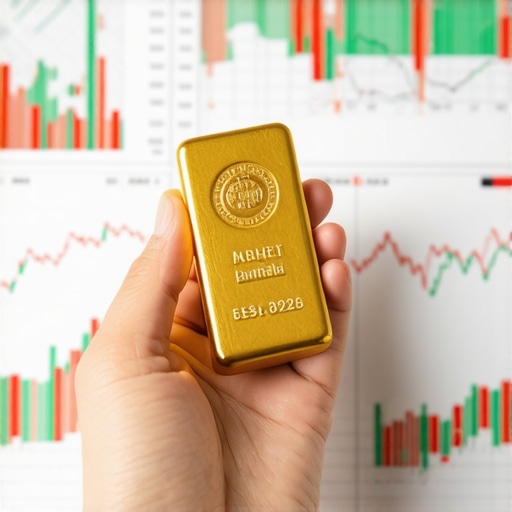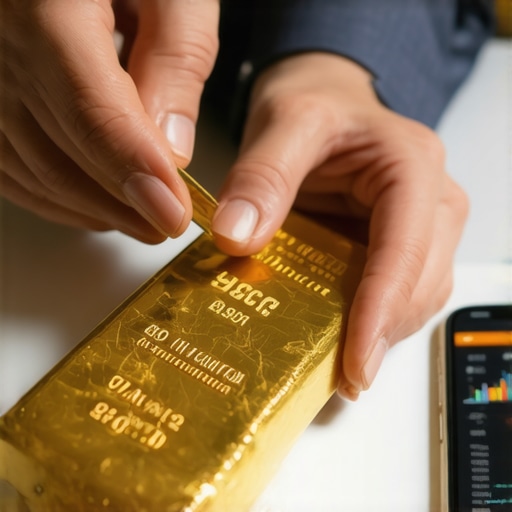Unlocking the Timeless Allure of Gold Investment
Gold has captivated investors for centuries, not just as a precious metal but as a strategic asset that can safeguard wealth and diversify portfolios. For beginners, the prospect of investing in gold can seem daunting — with myriad forms, market dynamics, and strategies to consider. However, approaching gold investment with a clear, informed roadmap transforms complexity into opportunity. This guide distills essential steps to set you confidently on your path to investing in gold.
Discovering Your Gold Investment Style: Physical vs. Paper Gold
One of the initial critical decisions is choosing between physical gold and paper gold assets. Physical gold includes coins, bars, and bullion, prized for tangible ownership and long-term security. Yet, it requires considerations about authenticity, storage, and liquidity. For instance, investing in well-recognized gold coins like the American Gold Eagle or Canadian Maple Leaf provides not only intrinsic value but also easier resale options. Conversely, paper gold investments such as Gold ETFs or gold mutual funds offer liquidity, lower transaction costs, and ease of purchase through brokerage accounts, ideal for investors prioritizing flexibility and diversification.
Strategically Timing Your Entry: Balancing Market Trends and Personal Goals
While gold is often viewed as a hedge against inflation and economic uncertainty, timing remains a nuanced art. Beginners should cultivate an understanding of macroeconomic factors influencing gold prices — including central bank policies, currency fluctuations, and geopolitical tensions. For example, during periods of rising inflation or market volatility, gold demand surges as investors seek safe havens. Nevertheless, attempting to perfectly time gold purchases can backfire; a disciplined approach aligned with your financial goals and risk tolerance is paramount. Resources like market expert timing strategies provide deeper insights into optimizing purchase moments.
Building a Balanced Gold Portfolio: Diversification and Risk Management
Investing solely in gold, while beneficial as a defensive asset, should be integrated thoughtfully within a broader investment portfolio. Diversification across gold forms (physical, ETFs, stocks), geographies, and complementary asset classes enhances risk-adjusted returns. For instance, combining gold stocks with physical gold and ETFs can capture upside potential from mining companies while maintaining the intrinsic stability of bullion. Beginners might explore how to choose the best types of gold investments to tailor allocations according to personal risk appetite and market conditions.
How Can Beginners Ensure Authenticity and Safety When Buying Physical Gold?
Authenticity and safety are paramount when purchasing physical gold. New investors should seek reputable dealers, insist on certified products, and understand hallmarking standards that verify purity. Secure storage options—such as bank safe deposit boxes or professional vault services—mitigate theft risks and preserve asset integrity. Learning to authenticate coins and bars through weight, dimensions, and assay certificates is also critical. Resources like this beginner’s guide to safe physical gold investment offer detailed protocols to avoid common pitfalls.
Harnessing Expert Knowledge: The Power of Informed Gold Investment
Embarking on your gold investment journey armed with expertise and strategic insight is crucial. Consider following market analyses from authoritative sources such as the World Gold Council, which provides in-depth data on global gold demand trends and price drivers. An understanding of these factors empowers investors to make decisions rooted in evidence rather than speculation. Additionally, engaging with trusted platforms and communities enriches your perspective and keeps you updated on evolving strategies.
Ready to deepen your knowledge and explore specific gold investment vehicles? Check out our detailed guide on starting with gold ETFs for beginners. Feel free to share your experiences or questions in the comments below — your journey to mastering gold investment begins here!
Reference: World Gold Council – Insights on gold’s role in portfolios and market dynamics (gold.org).
Understanding Gold’s Role in Portfolio Hedging Beyond Inflation
While gold is widely recognized as an effective hedge against inflation, its protective qualities extend into broader portfolio risk mitigation. Gold’s inverse correlation with equities and bonds during periods of market stress offers an essential diversification advantage. However, investors must appreciate that gold’s behavior is influenced by complex macroeconomic dynamics including interest rate shifts, currency strength, and geopolitical uncertainties. Incorporating gold requires tactical allocation strategies that consider these factors, balancing exposure to optimize downside protection without sacrificing growth potential. For practical insights on hedging strategies, explore our guide on top gold investment strategies to hedge against inflation.
The Nuances of Gold Mining Stocks: A Blend of Opportunity and Risk
Investing in gold mining stocks offers exposure to leveraged gold price movements and potential dividend income, but it also introduces company-specific risks such as operational challenges, geopolitical exposure, and management quality. Understanding financial health, reserve quality, and production costs of mining firms is critical. Diversification across various mining companies can mitigate individual stock risks while capitalizing on sector growth. For those considering this strategy, our comprehensive review of how to choose winning gold mining stocks in 2025 provides actionable criteria and market analysis to inform selection.
How Do Macroeconomic Shifts Influence Gold Investment Strategies for 2025 and Beyond?
Macroeconomic shifts such as central bank monetary policies, inflation expectations, and global geopolitical tensions fundamentally shape gold’s price trajectory and investor behavior. For example, tightening monetary policy and rising real interest rates can pressure gold prices, while geopolitical crises often drive safe-haven demand. Investors must integrate these variable dynamics into their gold investment strategies, adjusting allocations and timing to align with evolving economic landscapes. Staying informed through expert market forecasts and economic indicators, like those detailed by the World Gold Council, empowers investors to anticipate trends and optimize portfolio resilience.
Leveraging Technology and Data Analytics for Smarter Gold Trading
Modern gold investment increasingly benefits from technological tools such as algorithmic trading, sentiment analysis, and real-time market data analytics. These innovations enable investors to identify patterns, manage risks, and execute trades with improved precision and timing. Leveraging platforms that integrate these technologies can enhance returns and reduce exposure to market volatility. For investors eager to deepen their tactical edge, exploring resources like gold futures trading techniques provides practical guidance on utilizing tech-driven strategies effectively.
We invite you to share your perspectives or questions about advanced gold investment strategies in the comments below. Engaging with our expert community enhances collective knowledge and supports your journey toward sophisticated gold portfolio management.
Decoding Gold Price Volatility: Advanced Analytical Approaches for Informed Decisions
Gold’s price dynamics are influenced by an intricate web of factors, ranging from monetary policies and currency movements to investor sentiment and supply-demand imbalances. To adeptly navigate this volatility, seasoned investors employ advanced analytical methods such as quantitative modeling, machine learning algorithms, and sentiment analysis to detect subtle market signals. These tools help identify trend reversals, momentum shifts, and correlation breakdowns that traditional analysis might overlook. For instance, integrating macroeconomic indicators with big data analytics enables a more nuanced understanding of how geopolitical events or central bank announcements ripple through gold prices.
Moreover, volatility forecasting models, including GARCH (Generalized Autoregressive Conditional Heteroskedasticity), equip traders with probabilistic estimates of future price fluctuations, allowing for optimized position sizing and risk management. By harnessing these sophisticated techniques, investors can transition from reactive trading to proactive strategy formulation, improving timing and capital allocation efficiency.
Exploring the Role of Central Banks: The Hidden Drivers Behind Gold Demand and Supply Dynamics
Central banks are pivotal yet often underappreciated actors in the gold market. Their buying and selling decisions can significantly sway global gold supply-demand balances, influencing price trajectories. Understanding their strategic motives—ranging from currency diversification to geopolitical signaling—is essential for expert investors. In recent years, emerging market central banks have accelerated gold purchases to reduce reliance on the US dollar, thereby reshaping traditional market dynamics.
Analyzing central bank gold reserves reports and transaction patterns provides critical insights into potential supply constraints or surges. For example, heightened gold accumulation by the People’s Bank of China or Russia often signals strategic shifts with cascading effects on global investor sentiment. Incorporating these insights enables portfolio adjustments aligned with macroeconomic trends rather than short-term market noise.
What Are the Best Practices for Integrating Gold into Multi-Asset Portfolios to Maximize Risk-Adjusted Returns?
Integrating gold effectively within multi-asset portfolios demands a nuanced approach that balances its defensive characteristics with overall growth objectives. Experts recommend allocating between 5% to 15% of portfolio value to gold to achieve optimal diversification benefits without diluting returns significantly. This allocation should consider investment horizon, risk tolerance, and correlation dynamics with other asset classes.
Dynamic allocation strategies, such as tactical overweighting of gold during periods of rising inflation expectations or geopolitical uncertainty, can enhance portfolio resilience. Conversely, reducing exposure when real yields climb helps preserve capital efficiency. Utilizing portfolio optimization tools that incorporate gold’s historical and forward-looking covariance with equities, bonds, and alternative assets ensures allocations are data-driven and adaptive.
For detailed frameworks on portfolio construction incorporating gold, refer to the World Gold Council’s Portfolio Hedging Research, which offers empirical analyses and strategic guidelines.
Harnessing Blockchain and Tokenization: The Future of Gold Ownership and Trading
Blockchain technology is revolutionizing gold investment by enabling tokenized gold assets that combine the metal’s intrinsic value with digital liquidity and transparency. Tokenization allows fractional ownership, instant settlement, and reduced counterparty risks, democratizing access to gold investments beyond traditional barriers. This innovation also facilitates seamless integration with decentralized finance (DeFi) platforms, opening avenues for yield generation through staking or lending.
However, investors must exercise due diligence regarding custodial arrangements, regulatory compliance, and platform security. Understanding the underlying smart contracts and ensuring physical gold backing are imperative to mitigate fraud risks. Leading platforms offering tokenized gold solutions often provide audit certificates and insurance guarantees, enhancing investor confidence.
Exploring how to incorporate tokenized gold within existing portfolios can position investors at the forefront of financial innovation, capitalizing on enhanced flexibility and market reach.
We encourage you to deepen your expertise by engaging with our upcoming webinars on advanced gold trading technologies and strategic portfolio integration. Share your questions or insights below to join a community committed to mastering gold investment’s evolving landscape.
Deciphering Complex Market Signals: Leveraging Sentiment and Quantitative Analytics
In the evolving landscape of gold investment, advanced investors increasingly rely on multifaceted analytical frameworks that intertwine sentiment indicators with rigorous quantitative models. This convergence facilitates a deeper comprehension of market psychology and underlying price drivers beyond conventional fundamentals. For instance, integrating social media sentiment analysis with macroeconomic datasets can unearth early warning signs of market inflection points, enabling preemptive portfolio adjustments.
Moreover, machine learning models trained on historical gold price volatility alongside geopolitical event data can forecast potential price surges or downturns with enhanced accuracy. Such predictive capabilities empower investors to strategize entries and exits with a refined risk-reward balance, transcending traditional reactive approaches.
What sophisticated analytical tools can institutional investors apply to anticipate gold price volatility effectively?
Institutional investors harness a spectrum of advanced tools including GARCH models for volatility forecasting, neural networks for pattern recognition in price series, and natural language processing algorithms to parse geopolitical news impact. These techniques allow for probabilistic scenario planning and dynamic hedging strategies that adapt to evolving market conditions. Additionally, combining on-chain data analytics from tokenized gold platforms with traditional indicators offers a holistic view of liquidity flows and investor sentiment, enhancing decision-making granularity.
Unveiling Central Banks’ Strategic Gold Maneuvers: Implications for Market Dynamics
Central banks’ gold acquisition and disposition are often interpreted as barometers of monetary policy shifts and geopolitical positioning. The nuanced motives behind these transactions—such as attempts to diversify reserves or signal economic autonomy—necessitate expert-level scrutiny. For example, the sustained accumulation of gold by emerging market central banks like the Central Bank of India reflects strategic hedging against dollar dependency, reshaping global demand contours.
Analyzing quarterly International Monetary Fund (IMF) and World Gold Council reports reveals patterns in reserve management that sophisticated investors use to anticipate supply constraints or surpluses, informing tactical allocation adjustments. Understanding these institutional behaviors fortifies portfolio resilience amidst macroeconomic turbulence.
Tokenization and Blockchain: Pioneering Transparency and Liquidity in Gold Ownership
The advent of blockchain-enabled tokenization has introduced unprecedented transparency and fractional accessibility to gold investments. Tokenized gold assets, underpinned by verifiable physical reserves and governed by smart contracts, mitigate counterparty risks while enabling instantaneous settlements. This paradigm shift broadens investor participation beyond traditional barriers, fostering liquidity and facilitating innovative financial products within decentralized finance ecosystems.
Nonetheless, rigorous due diligence remains imperative: evaluating custodial integrity, audit trails, and regulatory compliance are non-negotiable prerequisites. Engaging with platforms employing third-party insurance and comprehensive audit certifications ensures asset security and authenticity. Early adoption of these technologies offers strategic advantages in portfolio diversification and operational efficiency.

Integrating Gold into Sophisticated Multi-Asset Portfolios: Tactical Allocation Frameworks
Incorporating gold within multi-asset portfolios demands dynamic, data-driven allocation strategies that transcend static percentage rules. Portfolio managers employ tactical overweighting during periods characterized by elevated inflation expectations or geopolitical uncertainty, while tactically reducing exposure when real interest rates rise. Utilizing advanced portfolio optimization algorithms that factor in gold’s evolving correlation matrix with equities, fixed income, and alternative assets enhances risk-adjusted returns.
Tools leveraging the latest research from authoritative institutions like the World Gold Council’s Portfolio Hedging Research enable investors to calibrate gold allocations contextually, optimizing capital efficiency and downside protection simultaneously.
Call to Action: Elevate Your Gold Investment Expertise with Expert Resources and Community Engagement
To harness the full potential of these advanced gold investment methodologies, we invite seasoned investors to delve deeper into specialized resources and participate in expert forums. Access comprehensive research reports from the World Gold Council to stay abreast of market intelligence and evolving trends. Engage with our upcoming webinars and analytic toolkits designed to sharpen your strategic acumen in gold portfolio management.
Join the conversation by sharing your insights or queries below — together, we can navigate the complexities of gold investment with precision and foresight.
Frequently Asked Questions (FAQ)
What are the primary advantages of investing in physical gold versus paper gold?
Physical gold offers tangible asset ownership, potential protection against currency devaluation, and privacy. However, it requires secure storage and verification of authenticity. Paper gold, such as ETFs and gold mutual funds, provides greater liquidity, ease of trading, and lower transaction costs but exposes investors to counterparty risks and lacks physical possession. The choice depends on individual risk tolerance, investment horizon, and preference for liquidity versus tangibility.
How can investors verify the authenticity of physical gold purchases?
Authenticity can be ensured by purchasing from reputable, certified dealers who provide hallmarking and assay certificates verifying purity and weight. Investors should familiarize themselves with standard gold specifications and consider third-party verification services. Secure storage solutions like bank vaults or insured custodial services further protect the asset’s integrity.
How do macroeconomic factors influence gold prices and investment timing?
Gold prices react to variables such as inflation rates, real interest rates, central bank policies, currency strength, and geopolitical tensions. Rising inflation or geopolitical uncertainty typically increase gold demand as a safe haven, while higher real yields may reduce its appeal. Investors should monitor these indicators to align their gold investment strategies with broader economic cycles and avoid attempts at precise market timing.
What role do central banks play in shaping gold market dynamics?
Central banks act as major buyers or sellers of gold reserves, influencing global supply and demand. Their strategic motives include reserve diversification, currency risk management, and geopolitical signaling. Tracking central bank gold transactions and reserve reports provides valuable insight into potential market shifts and long-term price trends.
How can gold mining stocks complement physical and paper gold investments?
Gold mining stocks offer leveraged exposure to gold prices and potential dividend income but entail company-specific risks such as operational challenges and geopolitical exposure. Including mining stocks can enhance portfolio returns during price upswings but requires thorough due diligence and diversification across multiple firms to mitigate idiosyncratic risks.
What are the benefits and risks of incorporating tokenized gold assets via blockchain?
Tokenized gold enhances liquidity, fractional ownership, and transparency through blockchain technology, enabling rapid settlement and integration with decentralized finance. However, risks include custodial counterparty exposure, regulatory uncertainties, and the necessity for rigorous due diligence on platform security and physical gold backing.
How much gold should be allocated in a diversified investment portfolio?
Experts generally recommend allocating between 5% to 15% of a portfolio to gold, balancing its role as a hedge and diversification tool without compromising growth potential. Tactical adjustments based on inflation expectations, geopolitical risks, and real interest rates can optimize risk-adjusted returns.
What advanced analytical tools help anticipate gold price volatility?
Institutional investors utilize techniques like GARCH volatility models, machine learning, neural networks, and natural language processing to analyze market sentiment, geopolitical news, and macroeconomic data. These tools improve forecasting accuracy and enable proactive risk management and strategic trade execution.
Why is diversification across different forms of gold investment important?
Diversification across physical gold, ETFs, mining stocks, and tokenized assets mitigates risks associated with liquidity, operational issues, and market fluctuations. It allows investors to capture various market opportunities while maintaining portfolio stability.
How can technology improve gold trading and portfolio management?
Technological advancements facilitate real-time data analytics, algorithmic trading, and sentiment analysis, enabling more precise market timing and risk control. Investors leveraging these tools can enhance returns and navigate volatility more effectively.
Trusted External Sources
- World Gold Council (gold.org): The premier authority on gold market data, demand trends, and strategic research, offering comprehensive insights into gold’s role in portfolios and macroeconomic influences.
- International Monetary Fund (IMF): Provides detailed reports on global reserve management and central bank gold holdings, crucial for understanding institutional demand and supply dynamics.
- London Bullion Market Association (LBMA): Industry standards setter and source for market infrastructure information, hallmarking standards, and verified gold trading protocols.
- Bloomberg Terminal & Financial Databases: Offer real-time market data, advanced analytics, and sentiment tracking tools essential for sophisticated gold price forecasting and trading strategies.
- Academic Journals on Commodity Finance and Econometrics: Publish peer-reviewed research on gold price modeling, volatility forecasting, and portfolio optimization methodologies.
Conclusion
Gold remains a cornerstone of sophisticated investment strategies, offering unique hedging capabilities and portfolio diversification benefits. Understanding the multifaceted nature of gold investment—from physical bullion to tokenized assets, mining equities, and advanced analytical techniques—empowers investors to tailor approaches that align with evolving macroeconomic landscapes and personal financial goals. Central bank behaviors, technological innovations, and dynamic allocation frameworks underscore the complexity and opportunity inherent in gold markets.
By integrating expert insights, rigorous due diligence, and cutting-edge tools, investors can navigate gold’s price volatility with confidence, harnessing its timeless allure to safeguard and grow wealth. We encourage you to leverage the trusted resources and engage with the expert community to deepen your mastery of gold investment. Share your thoughts, ask questions, and explore further expert content to elevate your strategic approach in this dynamic and rewarding asset class.










I appreciate how the post breaks down the initial dilemma many newcomers face: choosing between physical and paper gold investments. From my experience, physical gold does bring a comforting tangibility, but the storage concerns and need for verification can be daunting. I once bought some American Gold Eagles and learned quickly how important reputable dealers and secure storage solutions are. The paper gold route, like ETFs, certainly offers ease and liquidity, which can suit those balancing a busy lifestyle.
What intrigued me most was the nuanced discussion on timing and how macroeconomic factors influence gold prices. I’ve observed that aligning buy-ins with personal financial goals rather than trying to time the market perfectly has saved me from impulsive decisions during volatile periods.
I’d love to hear from others: how do you weigh the trade-offs between convenience and security in your gold investments? Also, what strategies have you found effective for balancing gold’s role within a diversified portfolio, especially in the face of shifting inflation and geopolitical tensions? Sharing practical insights could be invaluable for beginners stepping into this complex but rewarding market.